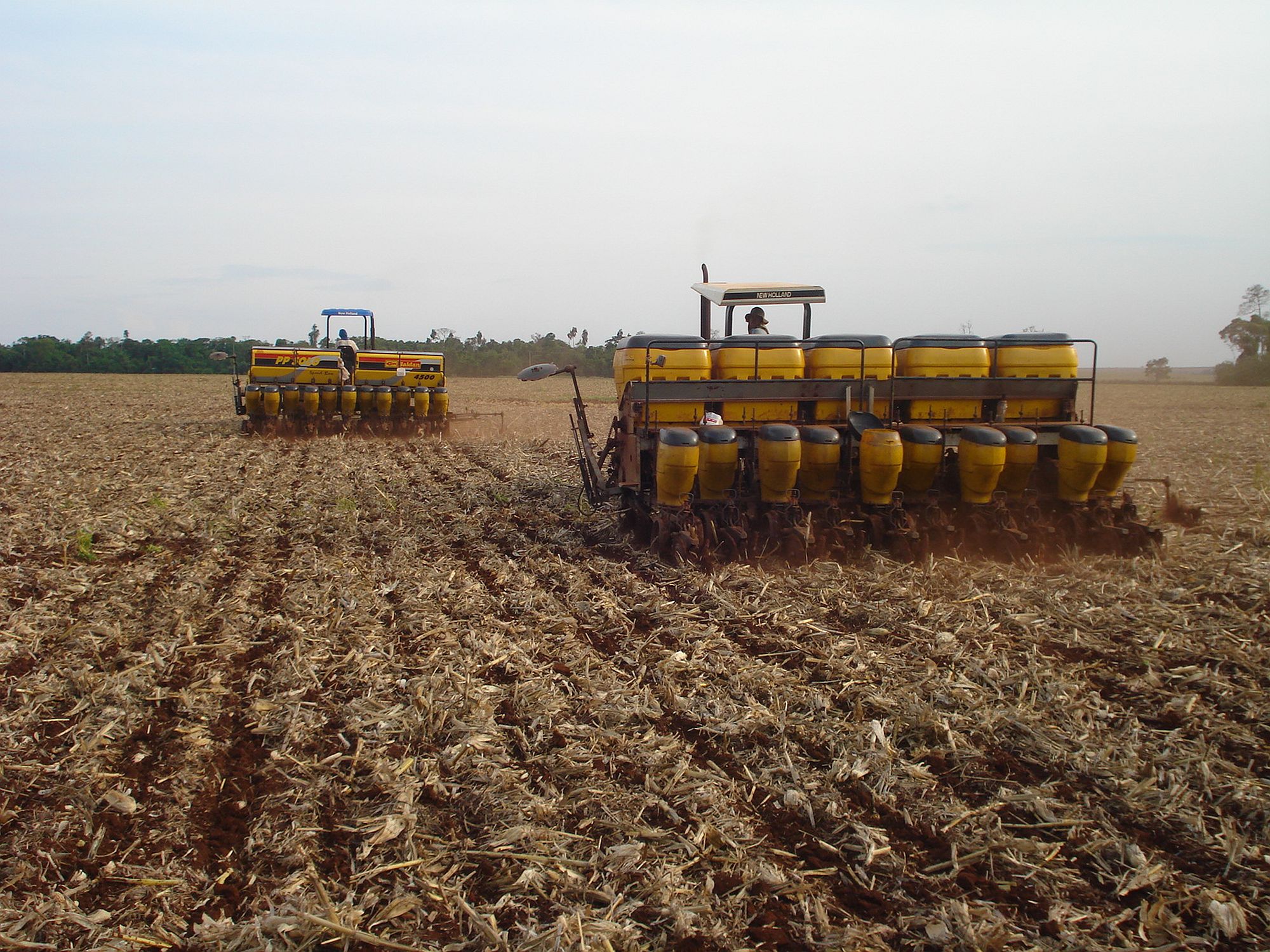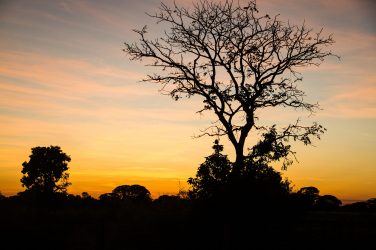The Amazon is burning. Once more, as in the 1990s, an “arc of fire” threatens planetary sustainability. Food production and consumption take their place at the center of the climate change emergency, as tropical forest is logged, burned and turned into agricultural cultivation.
In its recent report, the UN and the International Panel of Climate Change estimates that global food production is responsible for 21-37% of “anthropogenic emissions”. What lies behind this Anthropogen that treats humankind in general as responsible for the climate change emergency? The destruction of the Amazon is in fact the consequence of a geopolitical conflict, connecting Brazil to China, China to the US – and Brazil, as a member of the Mercosur, to the EU.
When it comes to the climate change crisis, the humble soybean has a lot to answer for. Not the bean itself, of course, but the human production and consumption related to it, and more particularly the national politics surrounding it.
When President Trump declared trade war on China, one of the direct impacts was a Chinese response placing 25% tariffs on soy imports from the USA. At the same time, after the election of President Bolsonaro in Brazil, previous legal limitations on deforestation of the Amazon and expansion into the Cerrado, in significant part for soy production, were relaxed.
As the deceptively named Environment Minister, Ricardo Salles, said in a recent interview for the Financial Times (23.08.2019), laws were too restrictive, and commercial development must instead “monetize” the Amazon. Turn fires into dollars.
The result is a perfect climate-change storm. Brazil had already overtaken the USA as the main exporter of soy in the second decade of the twenty first century. This trade war has stimulated a great leap forward in exports to China, already by far the largest importer of soy from Brazil – over 85% of Brazil’s exports by 2018.
Two climate-change denying Presidents, plus growing demand for soy as animal feed for China’s growing meat consumption, plus deforestation and land conversion in Brazil. Result? An explosive climate change acceleration event.
While this event is significant in its own right, it also challenges how we need to think about the nature of the climate change crisis. Two highly influential recent publications in Nature and The Lancet identifying the greatest risks of transgressing planetary boundaries for the sustainability of human (and non-human) life affirmed strikingly that “food production is the largest cause of global environmental change”.
It accounts for up to 37% of total global greenhouse gases, two and a half times more that total global transport. The urgency of addressing land use and food production and consumption has just been highlighted by the UN’s International Panel on Climate Change report, Climate Change and Land. It appeared only days before the news of the burning Amazon hit the headlines.
Moreover, world population is set to rise from nearly 7 billion to 9 billion. At least as significant, there are dramatic shifts in the food people consume, particularly transitions to greater meat consumption.
So, food perhaps presents the biggest but also the most intractable threat of the climate change crisis. In all the National Plans for climate change mitigation and underpinning the 2016 Paris Agreement, food production and consumption was marginalized, or even in many cases omitted. This potato was politically too hot to handle in many national contexts.
So, is this a crisis brought about by the human species in aggregate: The Anthropogen of the IPCC? Or, as many on the left have also argued, is this crisis a product of global capitalism, a general economic engine of limitless expansion and appropriation of nature: The Capitalogen of climate change crisis? Present profit before future planet.
The Trump-Bolsonaro, Brazil-USA-China, climate change crisis event illustrates why we need better social science than either of these globalist accounts, and certainly why we need to pay more attention to national politics in any analysis.
Food production and consumption are especially useful for forcing us to think directly of how different societies are endowed with different environmental resources, as an almost taken for granted, but nonetheless formative background for economic development, and for the national politics of that development.
Societies, and different political economies, differ enormously in how they generate greenhouse gases, how they consume energy, food, water, and how they trade internationally, with different climate change impacts. They also face different political challenges in confronting the climate change emergency. Not every country has the Amazon in its back garden.
Before I started my research into food production and consumption in China, I had not fully appreciated the scarcity of its agricultural land, in spite of its extensive national territory. It has less quality agricultural land per capita than even the UK, and a fraction of that of the USA or Brazil.
Its water resources for food production are even scarcer, a quarter of the world average. Within this environmental context, and following a long history of famines, the politics of food production was dominated by the twin imperative of food security and food self-sufficiency.
Following the death of Mao Tse Tung and the market socialist reforms of Deng Xiaoping, agricultural intensification was combined with a major fragmentation of land ownership under the Household Responsibility System. Egalitarian distribution of leasehold land to 250 million peasant farmers, market incentives, and huge increase in the use of chemical fertilizers aimed to satisfy the twin imperative.
As a consequence, from being a net importer of nitrogen phosphate fertilizer to a net exporter, China now uses more than 30% of the world total, more than the whole of Northern Europe and the USA put together. With peasants given subsidies to use fertilizers, the amount of fertilizer per hectare is many times that of Europe.
Both Chinese experts and the UN Food and Agriculture Organization recognize the result: an ecological catastrophe. Overuse of nitrogen fertilizer is a major source of nitrogen oxide, a powerful greenhouse gas. So, apart from acidification of the soil and eutrophication of surface water, rice production in particular contributes significantly to China’s greenhouse gas emissions.
And now, as agricultural productivity itself was threatened, China recognizes the problem, and has come up with its distinctive political solutions, a limitation of the use of nitrogen phosphates to a 1% increase until 2020, and a cap on total use thereafter.
This brief account exemplifies the need for the concept of sociogenesis of climate change. A distinctive political economy, operating within its specific land and water resource environment, generates a climate change crisis and then its own characteristic mitigation policies.
This is not a dynamic of a socially amorphous Anthropogen or a globalist Capitalogen in interaction with Nature in general. This is a distinctively Chinese dynamic, in its own environmental context.
Then, at the turn of the century, China recognized that limits of its own land-water resources were such that it could no longer equate food security with food self-sufficiency. Especially to meet the demand for increasing meat consumption, pork in particular, for a population previously unable to afford it, China decisively shifted to importing soy beans from Brazil to feed its expanding pig production.
Enter Brazil. Although Europe had led the way in using soy protein to replace animal protein after the BSE crisis, China followed on to become its biggest market. Brazil’s climate change crisis is almost the opposite to China’s.
From the time of the military dictatorship (1964-1975) there has been a politically driven process of expanding agricultural production through extensification, converting uncultivated land into agricultural land, in an inexorable progression from timber extraction, to cattle and soy production.
This led to the earlier “arc of fire”. Brazil is now the largest exporter of beef, poultry, coffee, orange juice, and, overtaking the USA, soy. Where China’s agricultural land was shrinking, Brazil’s was increasing by 5 million hectares every year since the 1990s, particularly into the Legal Amazon.
In Brazil, big multinational capital, much of it Brazilian, is certainly involved, dominating agricultural production. The top 1% of farms with over 1000 hectares occupy over 45% of cultivated land.
The Roncador Group has a farm of 150,000 hectares, the Amaggi Group Tanguro farm, 80,000 hectares. JBS is the top global meat producer and exporter in the world, and the total Brazilian beef herd now exceeds 200 million.
It is calculated that the methane production of this herd from enteric fermentation exceeds the CO2 emissions from Brazilian land clearance and deforestation.
This is the distinctive Brazilian climate change crisis, not a generic Capitalogen, but a politically fostered national economy in interaction with a unique resource environment. And, until the arrival of Bolsonaro, a distinctive set of policies was put in place to limit land extensification: the registration of land-ownership, pioneering satellite tracking of land incursions, moratoriums on soy and beef production on any newly converted land.
These mitigation policies succeeded in radically reducing, but far from eliminating Amazonian deforestation, and significant ecologies, notably the Cerrado in Mato Grosso, were much less protected.
One more sociogenic contrast. In both China and Brazil, with increasing per capita income, there has been a transition to eating more meat. China now outstrips the USA for pork consumption, and in overall meat consumption had reached an annual per capita quantity of 52.4 kilos in 2011.
Brazil has overtaken the European average, with 92.6 kilos, with beef the premier meat with its much higher GHG impact. None approach Trump beef steak America, with an average of 135 kilos for all meats.
At the opposite extreme, India with its Hindu nationalist vegetarianism, persecuting Muslim beef eaters, has the lowest per capita meat consumption, with a less pronounced transition to more people eating more meat. Cultures of consumption – not individual consumer choices – have major climate change consequences.
Out of sociogenic contrasts come sociogenic connections. Global food trade is not from anywhere to anywhere. Trade flows are highly structured, and in the case of China and Brazil, opposites attract. China’s lack of land and water resources creates the demand for Brazil’s abundance.
China’s politics of trade condition this trade: it imports only whole soybeans, for its own animal feed industry to process. A deal between Brazil and China to trade in national currencies escapes the dominant dollar as reserve currency for international trade. This is a specific nation-to-nation connection between production and consumption. From Brexit, as we know only too well, trade connections are politically made and un-made.
One of the major limitations of the UN brokered Paris Agreement with its national plans for climate change mitigation is that it only treats nations as GHG producers. Trade, and the connection between producers and consumers, is a sustainability black hole.
As has now become only too clear from President Macron’s finger-pointing at Bolsonaro, the trade agreement between the EU and the Mercosur failed to enshrine legal commitments on conserving the Amazon or the Cerrado. The soy connection between China and Brazil shows that nation-to-nation trade is a critical dynamic of the sociogenic climate change emergency.
This takes us back to the beginning. Trump and Bolsonaro have just pressed the accelerator on that dynamic. Economies are political, and the politics of economies are driving the climate change emergency. Combating climate change involves contesting those politics within our different societal and environmental contexts.
One more reason to be European in a European Union context, engaging in the politics of our shared environmental resources and for legally enforceable sustainable international trade. Or go down the route of environmental catastrophe with the Trump-Bolsonaro politics of planetary destruction.
Mark Harvey is Emeritus Professor at the Center for Research in Economic Sociology and Innovation at the University of Essex. He is also Honorary Professor, Department of Sociology, Sustainable Consumption Institute, University of Manchester.
His latest book is Inequality and Democratic Egalitarianism. Marx’s economy and beyond and other essays published by Manchester University Press.
This article appeared originally in Open Democracy – https://www.opendemocracy.net/






